
 |
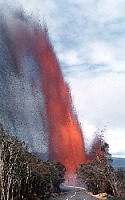 29 Nov. 1959, 9:00 a.m. |
The 1959 eruption of Kilauea Iki Crater was a relatively short-lived event, but it produced some of Kilauea's most spectacular lava fountains of the 20th century and yielded a wealth of valuable data about the volcano's magma reservoir system. This account summarizes key aspects of the remarkable summit eruption. Deep earthquake swarm & summit tiltEruption begins & fissures narrow to single vent Lava discharge increases dramatically Sixteen explosive episodes Lava drainback: where did it go? |
Three months before the Kilauea Iki eruption, between August 14 and 19, a great swarm of deep earthquakes and associated tremor was recorded on the smoke-drum seismographs at the Hawaiian Volcano Observatory. The earthquakes and temor were located about 55 km below the volcano. Weeks later, tilt surveys of the caldera using a new water-tube tiltmeter network indicated that, by early October, the summit of Kilauea was clearly beginning to inflate with new magma. Based on the deep seismicity and subsequent inflation of the caldera, scientists concluded that magma had started its upward journey during the August swarm and that the magma originated at a depth of about 55 km below the volcano.
Another series of earthquakes--very shallow tiny events beneath the caldera--began in mid September. The earthquakes were localized near Halema`uma`u Crater; they were barely detected by seismometers less than 2 km away. By November 1, more than 1,000 of the tiny earthquakes were being recorded. When scientists conducted another tilt survey of the caldera during the second week of November, they discovered that the caldera was swelling at least three times faster than during the previous months! Magma was moving into the summit reservoir at a high rate.
Then, during the afternoon of November 14, earthquakes beneath the caldera suddenly increased about tenfold in both number and intensity. For the next 5 hours, the entire summit region shook as magma forced its way from the summit reservoir toward the surface, breaking rocks along the way and shouldering them aside to make room for itself.
An erupting fissure broke through the south wall of Kilauea Iki Crater at 8:08 p.m. Abruptly, the swarm of earthquakes stopped, and seismographs around the caldera began to record the strong harmonic tremor characteristic of lava pouring out from Hawaiian volcanoes. When observers first reached the edge of Kilauea Iki twenty minutes later, lava fountains 15 m tall were erupting from a line of discontinuous fissures about 400 m long. Lava was cascading down the steep forested slopes to the bottom of the crater about 100 m below.
|
By 9:30 p.m., as magma continued to force its way to the surface along a narrow pathway, the erupting fissures lengthened to nearly 800 m, and the fountains increased to as high as 30 m. Small forest fires flared up on the crater walls, and burning trees with their bright yellow flames flashing like giant sparklers were carried swiftly down the lava cascades onto the growing lake of lava, where they floated slowly across the darkening surface until they burned out.
|
|
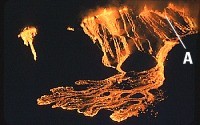 | med | large | |
This view from the present-day Kilauea Iki overlook (called Byron Ledge overlook in 1959) shows the maximum development of the erupting fissures in the south wall of the crater about 2.5 hours after the eruption started. The bright specks on the flows in the bottom of crater are burning trees. Within the next 24 hours, activity gradually stopped at all vents except one, which remained the sole vent for the rest of the eruption ("A" vent in photograph). |
|
The long line of fissures began to shrink after 10:00 p.m., and by nightfall on November 15, only vent "A" remained active. As lava fountains along the fissures stopped, the volume of lava erupted by the single vent increased. On November 16, the fountain was consistently reaching heights of 45-60 m. |
|
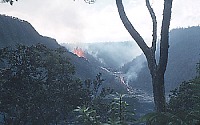 |
The solitary vent was located on the crater wall about 20 m above the smaller west crater of Kilauea Iki (top left). Lava poured through a breach in the spatter rampart below the lava fountain and cascaded down the crater wall to join a narrow channel that led to the larger east crater (85 m lower than the west crater). After about 300 m, the lava channel spilled down the wall of the east crater (slope ~30°) to form a series of lava rapids. The lava rapids (bottom left) were described as "a bright orange, incandescent, twisting ribbon that made a slurred gurgling sound as it glided past. At the bottom of the cascade a stationary wave of lava, similar in appearance to a standing water wave in rapids, crested 1 m above the level of the stream just before it widened into a sluggish river and disappeared beneath the frozen crust of the lake." |
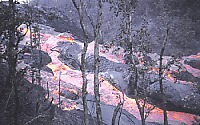 |
|
|
Just after the last photograph was taken, the photographer and his colleague had to beat a hasty retreat when the lava fountain at the vent increased suddenly and sent a "flood of lava" down the rapids. The surge carried automobile-sized blocks of semi-solid incandescent lava down the overflowing channel and into the rising lake! When the geologists retreated from the rapids on November 16, the lava lake was about 8 m deep. Throughout the eruption, they made frequent measurements of the rising and falling levels of the lake surface. Because the dimensions of the east and west craters of Kilauea Iki were known, the discharge of lava from the vent and subsequent drainback into the vent could be calculated accurately. This unique situation showed that the discharge began to increase rapidly on November 17. |
|
The lava fountain reached heights of 60-80 m by the early morning of November 17, and cinder, spatter, and pumice were falling onto the south rim of Kilauea Iki Crater, the leeward side of the vent. The falling fragments began to build a new cinder cone, which was eventually named Pu`u Pua`i (gushing hill). The fountain continued to grow in size throughout the day and was reaching heights of 100 m, with occasional bursts to 180 m, by early evening. Even as the cone was growing more rapidly because of the high fountains, parts of it broke loose and slid down into the vent.
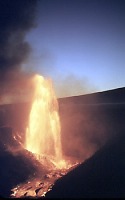 |
As the fountain continued to grow, reaching as high as 320 m on November 18 (top) and 350 m on November 19 (bottom), the lava channel between the west and east craters widened significantly. Slides from the inner face of the growing cone, Pu`u Pua`i, or possibly some other constriction of the vent, occasionally reduced the fountain height. At the same time, part of the fountain was deflected northward across the lava river to form spectacular V-shaped fountains (bottom). As impressive as the fountains were, the real story of the eruption was being told in the rapid rise of the lava lake:
|
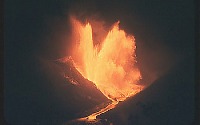 |
|
|
The peak discharge during this phase of the eruption was about 380,000 m3/hr between November 19-20. On November 21, the lake level rose above the vent, so that the fountain blasted through more than a meter of the lake before shooting skyward. This agitation in the lake at the base of the fountain generated large waves that rippled across the surface to the opposite shore, where they broke like waves on a beach. |
|
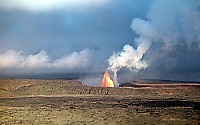 |
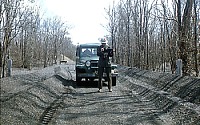 |
|
Left: Lava fountain in Kilauea Iki Crater as seen from the Hawaiian Volcano Observatory; note the black tephra deposit that is building a cone (Pu`u Pua`i) on the leeward side of the fountain. Right: Tephra covers the Crater Rim Drive Road and has stripped leaves and branches from the forest. The trees, though almost entirely defoliated, survived the eruption and flourish today. |
|
| Beginning at 7:25 p.m. on November 21, without any apparent warning, the fountain decreased from a spurting giant 210 m tall to a few gas bubbles in less than 40 seconds. The first and longest of many explosive episodes was over. |
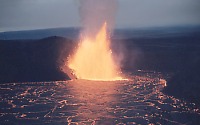 |
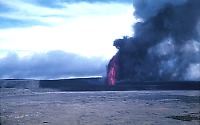 |
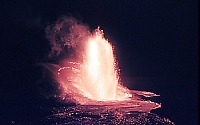 |
|
The next sixteen episodes were similar to the first, except for their smaller volumes of erupted lava and shorter durations. Lava that erupted from the vent collected in the lake, increasing its depth 3-20 m until lava rose over the vent and the base of the fountain (except for the final episode, which did not add much new lava to the lake). As lava covered the base of the fountain, the height of the fountain typically would fluctuate wildly before stopping altogether. At the end of several episodes, lava began flowing back into the vent even as the fountain continued. These drainback events were nearly as stunning and mesmerizing as the awesome fountains, especially at night. Huge slabs of thickening crust crumbled and were pulled apart by the retreating lava, exposing molten interiors, and sometimes a giant counter-clockwise whirlpool formed over the vent. Scientists and other observers worked hard to track the rise and fall of the lake as accurately as possible, so that the volumes of lava erupting and draining back into the vent could be calculated. The rate of lava draining back into the vent was often higher than rate of eruption. See diagram, volume of lava in Kilauea Iki Crater. |
||
The seven-day-long first episode erupted about 31 million m3 of lava into Kilauea Iki Crater. The next sixteen episodes, between Nov. 26 and Dec. 20, pumped an additional 71 million m3 of lava into the crater. Because of all the drainbacks, however, only 8 million m3 of lava actually remained in the crater when the eruption was over--the other 63 million m3 drained back into the depths of Kilauea! How could so much lava drain back into the ground and where did it all go? Did it drain back into the summit reservoir, into the east rift zone, or some other storage area? Did the "drained lava" erupt again during a subsequent episode? If so, what provided the driving force to erupt the same volume of lava over and over again?
Summary of magma budget during eruptionTwenty five years after the eruption, new analysis of the tiltmeter and seismic data spanning the eruption led to a detailed magma budget for the eruption (Eaton et. al., 1987). The data indicate that lava from Kilauea Iki lake did indeed return to the summit magma reservoir through an open vent-conduit system. The initial eruption of lava into Kilauea Iki (31 million m3) during the first episode, and the corresponding change in tilt of the caldera at Uwekahuna (about 50 microradians), established the scaling factor needed to relate changes in volume of the summit reservoir to tilting at Uwekahuna for the rest of the eruption.
For the entire eruption, the analysis showed that the summit reservoir gained about 10 million m3 of magma. During the eruption, 60 million m3 of magma rose into the summit reservoir from depth, 38 million m3 ended up in the lava lake, and 12 million m3 were driven out of the reservoir, possibly into the east rift zone. If lava had not been able to drain back into the summit reservoir (for example, if it had formed a lava-flow field in the summit area), the progression of the eruption would certainly have been different, and the summit reservoir might very well have "lost" magma by the time it ended. See figure of magma budget.
"Vesiculation pump" driving force of eruptive episodesOnce the vent and conduit were well established early in the eruption, an open system existed between the summit reservoir and the surface. Magma rose from the reservoir to erupt into Kilauea Iki Crater, or lava fell from the lake and poured into the reservoir, depending on the pressure conditions in the summit reservoir.
During the first episode, the summit reservoir lost 30 million m3 of magma to Kilauea Iki without being resupplied significantly from below. When the surface of the lake rose significantly above the vent, the heavy, partly degassed lake lava found entry into the conduit. This heavier lava added sufficient mass to the conduit to "choke" or prevent further vesiculation of magma in the reservoir, and the fountaining stopped abruptly on November 20.
Toward the end of this first episode, however, the downward tilt of the caldera at Uwekahuna reversed and accelerated, indicating that new magma was again filling the reservoir but at a much higher rate than before. Soon, the new gas-rich magma increased the reservoir pressure sufficiently to force lava up the open conduit to the vent in Kilauea Iki, starting episode 2. This time, the amount of pressure needed to force magma to the surface was much less, because of the open conduit. As lava poured into the lake again, raising the level above the vent, another cycle of drainback began and quickly prevented the vesiculation needed to sustain the fountaining and eruption. As magma continued to rise into the reservoir from depth, this cycle was repeated over and over until the eruption stopped on December 20.
Eaton, J.P., and Murata, K.J., 1960, How volcanoes grow: Science, v. 132, n. 3432, p. 925-938.
Eaton, J.P., Richter, D.H., and Krivoy, H.L., 1987, Cycling of magma between the summit reservoir and Kilauea Iki lava lake during the 1959 eruption of Kilauea Volcano, in Decker, R.W., Wright, T.L., Stauffer, P.W., (eds.), Volcanism in Hawaii: U.S. Geological Survey Professional Paper 1350, v. 2, p. 1307-1335.
Richter, D.H., Eaton, J.P., Murata, K.J., Ault, W.U., and Krivoy, H.L., 1970, Chronological narrative of the 1959-60 eruption of Kilauea Volcano, Hawaii: U.S. Geological Survey Professional Paper 537-E, 73 p.